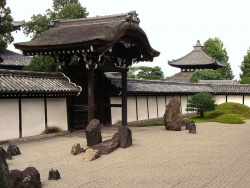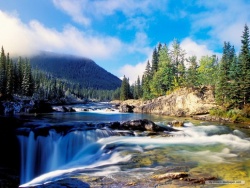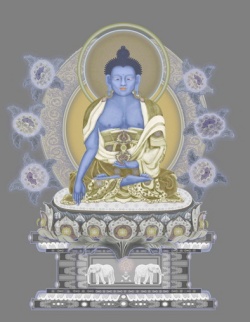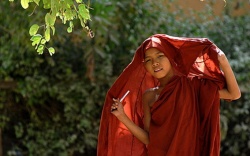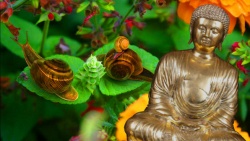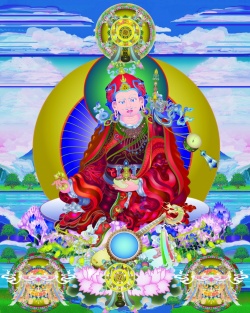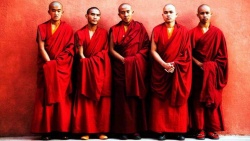An Angry Welcome - 17
On March 16, 1994, at about 9:30 in the morning, a car delivered eleven-year-old Tenzin Khyentse to the gate of the Karmapa International Buddhist Institute (KIBI) in New Delhi. Like Rumtek but smaller, the school is constructed on the plan of a Tibetan monastery, with a wall of student rooms forming a courtyard around a temple in the center.
Quietly, attendants took the youngster through the main courtyard, and then led him upstairs to a room on the third floor of the main temple building. There, the boy rested for a few hours, received instructions about the events of the next day and met with various lamas. Khenpo Ngawang Gelek, one of the teachers at the monk's school at Rumtek before the takeover in 1993, was one of these lamas. "I went to see His Holiness Karmapa to drop off a damaru (a ritual drum), and a bell, with Khenpo Chodrak's brother, Tashi. We entered his room and we bowed. Tashi then said we had brought very special toys today. But the Karmapa replied 'No, they are not toys.' That was the first time I met him."
Then, the boy was put to bed. None of the nearly one hundred students and staff of the school knew that the child who would be officially welcomed the next day as the seventeenth Karmapa was already on the premises.
Around seven o'clock the next morning, a large crowd assembled in front of the institute's main gate awaiting entrance to the festive event. Security guards frisked arrivals and searched their bags before allowing them inside. About five hundred guests were seated in the main temple for the ceremony. Most were monks and lay people from Rumtek and around the Himalayan area, but nearly two hundred Westerners, including about eighty students at KIBI, were in attendance as well.
Lea Terhune, who would write her book Karmapa: The Politics of Reincarnation ten years later, also came to attend the ceremony, in her capacity as a freelance correspondent for the Voice of America. Interestingly, Terhune had worked at KIBI several years earlier, during the eighties, before leaving to work exclusively with Tai Situ. On the morning of Tenzin Khyentse's welcome ceremony, Terhune arrived at KIBI with Tim McGirk, the writer for the London Independent who accused the tenth Shamarpa of starting the Tibet- Gorkha War of the eighteenth century, as we saw in chapter 7. Flashing press credentials, Terhune and McGirk managed to make it past the guards at the gate. But a KIBI staff member recognized Terhune as Situ's secretary, and asked her and McGirk to leave the premises. They were ushered past the main gate, and waited outside.
Inside the main temple, the guests were seated and the puja was ready to begin. At about eight o'clock in the morning, Shamar gave the word for the welcome ceremony to proceed. In procession under a traditional yellow umbrella, Shamar led Tenzin Khyentse into the temple, giving his eager followers their first glimpse of the boy they believed to be the seventeenth Karmapa. The boy wore glasses and walked between the two halves of the crowd as if he was used to appearing before hundreds of people on a regular basis. To the blare of gyaling horns and the rattling of cymbals Tenzin Khyentse walked slowly into the shrine room, moving with quiet confidence towards the oversized Buddha statue in the back of the room.
Under the gaze of the eyes of devotees who had come from around the Himalayas and around the world to welcome the new Karma Kagyu leader, the child stopped in front of the Buddha statue and performed three prostrations. Then, he mounted the throne reserved for the Karmapa, a seat that had sat empty from the day it was installed a decade earlier. The ritual master of the shrine, Nendo Tulku, handed the boy a replica of the Vajra Mukut, the Black Crown of the Karmapas, and placed a brocade robe around his shoulders. Horns, drums, and cymbals sounded. In a state of meditative concentratione new Karmapa placed the Black Crown on his head and the puja began.
Barbarians at the Gate
The ceremony continued for more than an hour. Inside the temple, there were monks and devotees chanting, musical instruments playing, and sticks of incense and butter lamps burning. At about 9:30 a.m., the ceremony drew to a close.
Meanwhile, outside the shrine room and across the street from KIBI, seven vans pulled up, bringing more than a hundred monks from Tai Situ's monastery Sherab Ling and dozens of lay people from Sikkim to begin a protest demonstration. A total of about two hundred protesters massed in front of the institute's gate and unfurled cloth banners with slogans written in English including "The Dalai Lama's word is our word," "Topga Yugyal [general secretary at Rumtek before the 1993 takeover] don't hide behind Shamarpa," "Joint Action Committee, All Buddhist Organizations of Sikkim," and "Stop using the boy." The demonstrators chanted slogans denouncing Shamar and Topga and promising to expose their "fake Karmapa." The KIBI management identified some of the monks as the same shedra students who had overwhelmed the sixteenth Karmapa's monks at Rumtek and had helped expel them when Situ and Gyaltsab took over the monastery in August 1993.
According to Indian journalist Anil Maheshwari, "Shamar Rinpoche was aware that the following day Situ's men would try, at all costs, to stage a demonstration in front of KIBI." [1] But Khenpo Chodrak Tenphel, the abbot of Rumtek before August 1993 and the director of KIBI at the time of Tenzin Khyentse's welcome ceremony, denies any advance knowledge about or planning to respond to a protest.
"We did not expect any kind of demonstration and certainly not the attack that did happen," Khenpo Chodrak said. "That's why we did not try to keep the welcome ceremony a secret, but we announced it a month in advance, so that our guests could attend. KIBI is located in a development in New Delhi with business schools, a hospital, and a Hindu ashram, but no other Tibetan centers of any kind, so we thought there would be no trouble from our neighbors. Also, there are more observers in a city like New Delhi. We had invited journalists from the Times of India and the Indian Express. Troublemakers can't get away with so much in a big city. The situation was different than at Rumtek, which is in Sikkim, a far-off state that could be dominated by a corrupt little regime like Bhandari's. If we had expected a problem at KIBI, we would have simply asked the New Delhi police for protection."
Writer Terhune witnessed the fight from outside the gates of KIBI: "Outside, a contingent of monks from Delhi and Himachal Pradesh were assembled to demonstrate against Shamarpa and what they saw as a sacrilegious introduction of a fake Karmapa. It was meant to be a silent protest. It was unclear who cast the first stone." [2] But for the five hundred guests at the ceremony and the KIBI staff, it was clear that Tai Situ's supporters launched an unprovoked attack on KIBI to disrupt the welcome ceremony for Shamar's "Karmapa candidate. This version of events is backed up by dozens of eyewitness accounts and fourteen minutes of video footage shot by an Austrian filmmaker who had come to New Delhi to record the ceremony. [3]
The protesters were apparently disappointed to find that they had missed nearly the whole welcome ceremony. Just as the puja was concluding inside the temple, outside the monks started picking up stones and bricks from the street. Then, they charged, the institute's locked gate. The three or four private security guards inside panicked and then fled. Though a couple of KIBI monks tried to hold the gate, a surge of protesting monks pushed through and flooded into the courtyard. Once inside the KIBI gates, the protesters began throwing their stones and bricks at the main temple, aiming at any windows they could reach.
As glass started to shatter, the monks and guests in the temple exchanged looks and then sprang to their feet. Bricks and stones began to crash through the windows onto the heads of the crowd inside. The puja finished just at this point. A KIBI official signaled the ritual master to conclude the ceremony. Then, he asked the crowd to remain calm and urged everyone to take cover, assuring visitors that the police had already been called and would arrive soon. KIBI monks and staff ran outside and tried to push back the invaders.
"One journalist who wasn't thrown out reported that projectiles such as coke bottles and bricks were stockpiled on the roof of the monastery, apparently for just such an eventuality," Lea Terhune wrote. [4] But KIBI staff members tell a different story. According to Khenpo Ngawang Gelek, after the protesters began to throw stones and bricks at the temple windows, on their own initiative, the mostly-Nepali kitchen staff began collecting bottles that they normally saved to return for a deposit. They ran the racks of bottles upstairs to the roof. From there, they rained down bottles on the courtyard to try to scare off the attackers. They had no bricks. Dropping bottles helped to contain the fighting, and later the KIBI management paid each kitchen staff member a bonus for his or her role in the institute's defense.
Meanwhile, attendants brought Tenzin Khyentse down from the throne and waited with him on the stage at the back of the main shrine room for ten minutes until the fighting subsided. Thaye Dorje described his own impressions of the attack to me. "I simply didn't know what was going on. I just thought there were so many visitors that they were trying to crowd in to see me. It's like that in Tibet. People see a rinpoche once or twice in their lifetimes and they just have to push their way in to get a blessing, it's their only chance. So there are many crowds like this at special ceremonies, people just barge in. Later, when the lamas put me behind the throne, I didn't really understand why."
Once it was safe to leave the shrine room, his attendants took Tenzin Khyenrse upstairs to his room on the third floor. From his window there the boy looked down at the fight below as it was winding down. He said that he still wasn't scared for himself, but that he was concerned that others might get hurt. "When we went upstairs and looked out the window, I suggested that we bring out big water hoses to push the crowd away without hurting them," Thaye Dorje told me.
Khenpo Ngawang Gelek was with the young lama. "The protesters carne into the courtyard, just at the end of the ceremony," he said. "They kept shouting and throwing stones. Karmapa went to his room and was watching from a window to see what they were doing. He wasn't scared at all."
During the melee, a young Polish student of the Danish Lama Ole Nydahl managed to close the main gates but was badly injured in the process by monks from Situ's group. Blood from a head wound that the young man had sustained splattered onto the shirt of Tim McGirk, the London Independent reporter who carne with Lea Terhune. During the fighting, the KIBI monks invited McGirk into the facility to make sure he was not injured. They washed his shirt. This gave him a chance to ask questions of Shamar Rinpoche. McGirk told Shamar that he had somehow gotten the idea that Shamar's monks were the aggressors, and that they were trying to take over the monastery.
"I think the reporter got things backwards," Shamar said. "As d1e fighting went on outside, I talked with Mr. McGirk. When he saw that the stones were actually coming from outside the gates, he asked me 'Shouldn't you be throwing the stones?' Then, I said to him 'Why would I want to injure my own monks?' He looked puzzled. Then he said 'But you're supposed to be taking over the monastery.' I explained that KIBI was already under my management and that it was Situ Rinpoche's monks who had come to disrupt the ceremony. The reporter looked at me again and then he looked down at the ground. He obviously thought that Situ's monks were already inside KIBI and that our monks were attacking. Maybe it was too big a change from what he had come to expect and he couldn't understand the true situation."
Despite what he must have seen for himself, McGirk later published his article blaming the fight on Shamar and his monks. Though he admitted that the protesters threw the bricks, McGirk implied that they had good reason to do so. "The tale took a more sinister twist when, in Delhi yesterday, Shamar Rinpoche unveiled his candidate for 17th Karmapa, a shy, rather scared 11-year-old Tibetan. Three coach loads of Tibetan monks and students arrived and waged a fierce battle with Shamar's renegade followers. 'Shamar's manipulating this boy for money and power,' shouted one protesting monk as he threw a brick." [5]
The Indian press would have less trouble understanding the situation at KIBI. One national paper in New Delhi wrote: "A ceremony to-crown a 10-year-oid [sic] Tibetan boy as the one chosen to be Karmapa, head of the prestigious Rumtek monastery in Sikkim, ended on a violent note Thursday morning when members of rival Buddhist group, who plan to install another boy living in Tibet as Rumtek chief, reached the scene and indulged in heavy brickbatting." [6]
While Shamar was talking to McGirk at KIBI, the battle in the courtyard went on for about five more minutes, until the New Delhi police arrived. Once on the scene, police officers arrested nine protesters for inciting violence and committing assault. About twenty people were injured, including monks who had been violently expelled from Rumtek just seven months earlier. The institute sustained several thousand dollars in property damage. While the main shrine room had largely been spared, nearly every window on the premises was broken, a walkway had been ripped up, the rails and posts of a protective fence had been torn out, and the guardhouse at the front gate had been sacked. "The KIBI courtyard was covered with bricks, stones, and broken glass and stained with spots of blood. It looked like the scene of a big riot," Khenpo Ngawang Gelek told me.
First as Tragedy, then as Farce
In the Eighteenth Brumaire of Louis Napoleon, Karl Marx wrote: "Hegel remarks somewhere that all great world-historic facts and personages appear, so to speak, twice. He forgot to add: the first time as tragedy, the second time as farce." To Shamar and his followers, the takeover of Rumtek by Situ and Gyaltsab in 1993 was a tragedy that deprived many of them of their home and put the monastic seat of the Karmapas under the influence of their historic rivals in the Tibetan administration of the Dalai Lama. By contrast, the attack on KIBI the following year turned out to be little more than an annoyance for supporters of the new Karmapa.
On the same day as the welcome ceremony for Tenzin Khyentse, the Dalai Lama was addressing a human rights conference. After his speech, word of the attack at KIBI got out. Two facts, that the protester-attackers were supporters of the Dalai Lama's Karmapa candidate, and that they carried banners invoking the Dalai Lama's authority, reached attendees at the conference. In response, a group of foreign delegates sent a memo to the Tibetan exile leader asking him how he could criticize Chinese human rights violations while he himself was involved in this incident that threatened freedom of religion for his own Tibetans in exile. I was not able to discover what answer, if any, the Dalai Lama gave.
A few days later, Tai Situ held a news conference in New Delhi to give his opinion of the events at KIBI. Standing in front of a large photo of the Dalai Lama, and with hands in prayer position, Situ answered questions from a podium. When a reporter asked Situ if his monks had attacked KIBI, according to witnesses, the rinpoche replied mendaciously that he did not know who the attackers were, but that he heard they might have been Nyingma monks. Situ did not add that many of the protesting monks came from his own monastery, Sherab Ling.
He then spoke about the need for world peace and cooperation, hearkening back to his aborted Pilgrimage for Active Peace of five years earlier. "The peace and harmony of "the sacred order, which has been laid down by the Karma Kagyu tradition of Tibetan Buddhism has been disturbed." [7] Finally, when a reporter from an Indian magazine asked him what would happen if Shamar tried to enthrone his Karmapa candidate at Rumtek, Sint replied I'm afraid that may lead to a bloodbath in Sikkim." [8] This was taken by the monks who had been thrown out of Rumtek in August 1993 as a threat.
Three months later, in June 1994, Tai Situ's attorney Ram Jethmalani brought a suit against Shamar for control of KIBI in the High Court of New Delhi. Jethmalani argued that since Ogyen Trinley had been recognized as the seventeenth Karmapa, his "regents" Tai Situ and Gyaltsab had the legal right to control the Karmapa's school, KlBI. Jethmalani was a formidable opponent, a charismatic courtroom presence, and one of the best known lawyers in India. We have already seen how Jethmalani got the ban on Situ entering India lifted. However, this time, Shamar's attorney, a young unknown lawyer named P.K. Ganguli, produced arguments that convinced the court to dismiss the case at its first hearing.
An Education Ancient and Modern
Tenzin Khyentse was uninjured by the attack on KlBI, and this rough welcome did little to reduce his joy at being united with Shamar and having the opportunity to study under the teachers at the Karmapa Institute. "My traditional monastic education continued. But now I met with more teachers, especially Topga Rinpoche. Also Khenpo Chodrak. I was able to properly start on Tibetan grammar. I started English at this time too, studying with a Russian man who then lived in America. Later I had teachers from Australia and other countries, so my accent should be a bit mixed. I also got a smattering of math, science, and world affairs."
In November 1996, in the Mahabodhi Temple at Bodh Gaya, where Shakyamuni Buddha had gotten enlightened twenty-five hundred years earlier, Tenzin Khyentse had his hair- cutting ceremony and rook monks' vows. He officially took the name Trinley (Buddha Activity) Thaye (Limitless) Dorje (Unchanging). In 1998 Khenpo Sempa Dorje, one of the most prominent scholars of the Tibetan monastic tradition and a professor at Banaras Hindu University in Varanasi -- which claims to be one of the three largest residential universities in the world, with 128 teaching departments -- began to tutor tile Karmapa on Buddhist philosophy. Interestingly, Sempa Dorje was trained as a Gelugpa geshe, again showing that some individual lamas of the Dalai Lama's school are not scared off by the Karmapa controversy.
In 1997, Shamar was able to arrange a meeting for Thaye Dorje with the Dalai Lama in Dharamsala. Shamar has insisted that he did not want to obtain the Tibetan leader's approval, and he has continued to assert that the Dalai Lamas had never had any authority to choose or recognize a Karmapa. But Shamar wanted the meeting to demonstrate that the Tibetan leader was not implacably opposed to Thaye Dorje. The Dalai Lama signaled that he was ready to meet Thaye Dorje, and a time was set. Then, the meeting was just as quickly cancelled. "Beforehand, Situ's supporters found out about our meeting with His Holiness Dalai Lama," Shamar said. "They threatened to make the streets of Dharamsala run with blood if the meeting took place. Therefore, His Holiness had no choice but to postpone this meeting."
In November 1999, Thaye Dorje accepted an invitation to make a tour of Southeast Asia. This would be his first trip abroad. He met with thousands of devotees at dharma centers in Singapore and Malaysia. But he almost did not make it into Taiwan, according to Ngedon Tenzin. Earlier, we encountered him as the senior monk-official at Rumtek who had his monk's robe wrapped around his neck by angry local supporters of Situ when he and Gyaltsab took over the Karmapa's cloister in August 1993. Since 2004, as we have seen, Ngedon has served as the general secretary of Thaye Dorje's labrang, the post held by Topga Rinpoche until his death from cancer in 1997.
"Our staff obtained a Taiwanese visa for Gyalwa Karmapa Thaye Dorje weeks before he was supposed to enter Taiwan. We used the diplomatic passport issued to him by the Bhutanese government," Ngedon said. "But the day before he was due to fly into Taipei airport, officials in the Foreign Ministry tried to stop His Holiness Karmapa from coming in because of a technicality."
Immigration officials noticed that his passport said that Thaye Dorje was born in Tibet. As a result of its strained relations with Beijing, the Taiwanese government required travelers born in China to obtain a special permit to enter the island nation. Only the timely intervention of one of Thaye Dorje's supporters in Taipei saved the trip. This devotee used his influence in the Foreign Ministry to convince the manager of the relevant office to remain open after normal closing time at five o'clock to process an emergency permit for Thaye Dorje. The tulku was able to obtain clearance and fly into Taipei the next day.
Ngedon suspects that Chen Lu An, who by this time was a former government official but one who still enjoyed influence in the tight-knit administration of the island nation, tried to block Thaye Dorje's entry into Taiwan. "Through our devotees in Taiwan" we heard that Mr. Chen had already lined up perhaps fifty people willing to pay one million dollars each to carry the box for the Black Crown and hand it to Ogyen Trinley during the Black Crown ceremony," Ngedon said.
Here we might recall that Jigme Rinpoche accused former Rumtek Abbot Thrangu of planning with Chen to tour the next Karmapa around the island to raise funds, as we saw in chapter 8. Now, it appeared that Chen had started to put a similar plan into action with Tai Situ.
According to Ngedon, Chen had even more Taiwanese pledged to pay five hundred thousand dollars each to hand Ogyen Trinley the so-called Body, Speech, and Mind Objects during the ceremony -- a stupa or sacred pagoda, a statue of the Buddha, and a text of Buddhist scriptures. "Mr. Chen had made commitments to Karma Kagyu lamas in Taiwan, as well as monasteries around the world, from Kathmandu to New York, to distribute these funds. If His Holiness Thaye Dorje came to Taiwan, Mr. Chen's plan would be spoiled. We heard that he was practically sleeping in front of the Foreign Ministry office to stop Karmapa Thaye Dorje from getting into Taiwan."
As it turned out, Thaye Dorje received a royal welcome on the island. The Karmapa controversy led coverage on the local television news for a couple of days. Meanwhile, Thaye Dorje gave empowerment ceremonies around Taiwan and toured the Taiwanese legislature and the studios of a major television station. "In the city of Tainan, more than ten thousand devotees attended one of his ceremonies. The line of people waiting for blessings was endless," Ngedon said. "At some point, we had to stop, or it could have gone on forever. About two hundred lamas who supported Ogyen Trinley attended Thaye Dorje's empowerment~ just to get donations themselves from the generous devotees."
In January 2000, Thaye Dorje went on to Europe, giving teachings to and performing ceremonies for thousands more students. He concluded his European visit with a retreat at the Dhagpo Kagyu Ling center in France, under the management of Shamar's elder brother Jigme Rinpoche.
At that time, when he was sixteen years old, Thaye Dorje explained that traveling was an important part of his education. "There are many new things that I have never experienced before, both good and bad, but my main discovery was the differences in culture. In each country, they have their own way of talking or relating to each other. In every aspect of life, there's something different, so that has been quite interesting to see. Otherwise, what I really like the most is that people are genuinely devoted to dharma. Since I'm a teacher, that's what I am looking for. There are many people who are really interested and who do their practice from the heart, and that's been the experience I have liked the most." [9]
When he travels, particularly around Asia, Thaye Dorje is often met with Byzantine protocol and extravagant displays of devotion and respect. During his first visit to Europe, he said that "it is totally wrong to see a lama as some kind of supernatural being. A lama is someone who shows the path to enlightenment, and that's it. He's simply a teacher. It is similar with the Three Jewels: you can rely on the Buddha and the Sangha because they've been through this samsara, know what it is and how to overcome all this suffering; the dharma is the path for this aim. This kind of special treatment, I really don't expect it and I don't want it. It is not important for me. All I want is to help people find real happiness. What I mean is the real happiness that is achieved in the state of liberation. I myself go through my spiritual practices in order to become able to guide others on this path. It is for this reason that 1 am getting the teachings from all the high lamas, teachers and professors." [10]
The young lama has divided the last few years between studying at the monk's school in Kalimpong and traveling. In December 2003 he went through his Vidyadhara ceremony, a kind of graduation held at the Karmapa Institute in New Delhi to signify the completion of his formal monastic education. However, at Shamar's urging. Thaye Dorje has continued to study Buddhist philosophy at the monk's school in Kalimpong as graduate-level study. Shamar, who is in charge of Thaye Dorje's education. said that, "I want His Holiness Karmapa to receive the broadest schooling possible in Tibetan Buddhist studies and also to gain a basic knowledge of Western science, culture, and thought, for the modern world."
In the summer of 2004, to introduce Thaye Dorje to Western philosophy, Shamar invited Harrison Pemberton, the philosophy professor who accompanied me to Rumtek, to teach Thaye Dorje in Kalimpong. Pemberton had just retired from forty years in the philosophy department at Washington and Lee University in Lexington, Virginia. Pemberton accepted Shamar's invitation, and he began teaching in Kalimpong in October 2004. For five weeks, Pemberton tutored the young tulku and five other young lamas on his specialty, the dialogues of Plato. Pemberton ran his class solely in English with no Tibetan translator present and he taught in the style of an American seminar course, with the emphasis on discussion over lecture. "In the tradition of Socratic dialogue, I really wanted class to be an interactive encounter," Pemberton said.
Along with Plato, Pemberton also introduced the leading philosophers of the European tradition including Descartes, Kant, Hegel, and Heidegger. "This will be the first Karmapa who can bring together East and West on an intellectual level," said Pemberton. "He was particularly interested in the role of Socrates as a guru, prodding students towards knowledge and wisdom. I don't know if I'm a Buddhist or not, but I can say that the Karmapa displayed one of the sharpest analytic minds I have ever encountered."
Tantra in California
Thaye Dorje made his first trip to the United States in June, 2003. On this low-key visit, he remained in California. He spent two months studying in the Menlo Park home of Sandy Yen, a sponsor from Silicon Valley's thriving Chinese-American community. The young lama used the relative isolation of Yen's residence from his normal responsibilities as an opportunity to fulfill a long-held dream of the sixteenth Karmapa. In the eleventh century, the legendary Tibetan founder of the Kagyu lineage, Marpa the Translator, brought fifty tantric ritual texts from India to Tibet. He passed on the empowerments for these texts to his students, and these texts became valued lore of the Kagyu linage until the death of the last teacher who could pass them on in the nineteenth century.
Fortunately, the nineteenth-century scholar Jamgon Kongtrul the Great had preserved these texts and passed them on to lamas of the Sakya school. The Sakyas in turn passed along the oral teachings surrounding these texts up to the present day within their own school. The sixteenth Karmapa had wanted to receive these Tantras from the Sakya lama Chobgye Trichen Rinpoche in the mid-1960s in Sikkim. But, since Sikkim had not yet joined India, permission of its traditional ruler, the Chogyal, was necessary for Chobgye Trichen to enter the small kingdom. This permission could not be obtained. The sixteenth Karmapa never had another chance to receive the empowerments for these texts, and he died without realizing the dream of returning them to the Karma Kagyu.
Thaye Dorje decided to fulfill this dream. Originally, he wanted to receive the Marpa Tantras from the Chobgye Trichen himself, but the elderly lama's health did not permit him to travel. Another high-ranking Sakya lama, Ludhing Khenchen Rinpoche, agreed to present the empowerments to Thaye Dorje and to Shamar as well. After more than a century, these fifty tantric texts from Marpa and their oral teachings returned to the Kagyu lineage in a series of sessions held in a ranch house in northern California.
After receiving these empowerments, Thaye Dorje then went on to give more general teachings and empowerments to his students in California. He said he liked the United States, "in America everything is very big ... I see big roads, big cars, even big people (laughter), But generally, people have open minds, which is very important tor Buddhism." [11]
In the summer of 2004 Thaye Dorje made a two-month tour of Europe, giving teachings at dharma centers and holding empowerments in auditoriums in nine countries. At the beginning of the tour, Thaye Dorje consecrated the new Kalachakra stupa at Ole Nydahl's center in Malaga, Spain. This forty-foot-high stupa is one of the largest in the Western world. In Hamburg, the young lama attended a twenty-fifth anniversary celebration for Nydahl's center. Also present were Nydahl himself, the mayor, members of the city's senate, and the Lutheran Bishop of Hamburg.
In Braunschweig, Thaye Dorje blessed an abandoned factory that Nydahl's students were turning into a dharma center. In Copenhagen, he gave a forty-minute interview to Denmark's largest TV station. In Perpignan, France, the young lama attended an inter-faith conference with Christian, Jewish, and Muslim representatives. In Kuchary, Poland. he gave interviews to TV stations and to Poland's largest weekly magazine, Prtekroj. In the same city Thaye Dorje also gave the empowerment of Amitabha Buddha and the Bodhisattva Vow to three thousand devotees from Poland, Russia, the Ukraine, Lithuania, and other eastern European countries.
On his plans for the future, Thaye Dorje told me that he will finish his formal education in 2006 and then devote himself to travel and teaching worldwide. "There are already many dharma centers started around the world. Maybe fifty new centers a year are started. There are a lot of eager people, a lot of intelligent people. They keep me going and give me inspiration to study and practice well so to really be able to help others."
Thaye Dorje has already become the most cosmopolitan lama in the history of the Karmapas, but his philosophy of life remains that of the first Karmapa Dusum Khyenpa or for that matter, Shakyamuni Buddha. His favorite movies are The Lord of the Rings series. He edits Tibetan texts on his laptop and thinks that the Internet can be a powerful tool for his teaching. "Certainly, for our Buddhist activity, I think it's quite important," he said. "What we do is we teach. so all the teachings can be written down and put on the Internet. Thanks to the Internet, our teaching can reach a wider audience. One good thing there is to see is that for youngsters, the Internet is their life. They really enjoy it, you know? If we use the net to give more information about dharma, youngsters can have better contact with the teachings."
Thaye Dorje recognizes that because of the Internet and mass media people today may suffer from data overload. But he does not think the confusion caused by too much information is a new one. "I think that's quite normal. It's not just because of the Internet, it has always been like that. To think that it's happening only now is like saying that things were perfect in the past, and that's not true." [12]
In line with the Buddhist view that time and history are cyclical -- good eras alternate with unfortunate ones in an endless cycle -- he considers other problems of the contemporary world as nothing new. Perhaps this is why Thaye Dorje does not propose political reforms such as programs for world peace or environmental cleanup, but instead, like his predecessors, he offers what Buddhism would consider a more fundamental approach. He thinks that international terrorism, for example, is a sign of a deep malaise of our era, a malaise that was foretold in Buddhist prophecy. "Now as it says in the Buddha's teachings, is a time of degeneration," Thaye Dorje told me. "More and more problems will arise in the future. We should take that as a reason to practice dharma and make an effort to save ourselves and all sentient beings. We should practice diligently."
Thaye Dorje's approach to practice and its final goal is rigorous but practical. He realizes that many Westerners may think that enlightenment is an impossible goal but he counsels them not to give up on it. "It's really far to reach the full enlightenment of. the Buddha. We don't really have to reach that stage now though. We can reach the first Bodhisattva bhumi or level. We can also keep the Bodhisattva Promise and be virtuous in our thoughts and actions."
